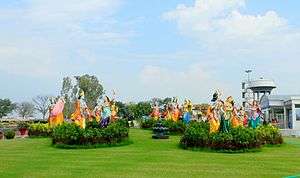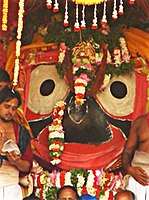Gita Govinda
The Gita Govinda (Sanskrit: गीत गोविन्द) (Song of Govinda) is a work composed by the 12th-century Hindu poet, Jayadeva. It describes the relationship between Krishna and the gopis (female cow herders) of Vrindavana, and in particular one gopi named Radha.
| Gita Govinda | |
|---|---|
| Information | |
| Religion | Hinduism |
| Language | Sanskrit |
The Gita Govinda is organized into twelve chapters. Each chapter is further sub-divided into twenty-four divisions called Prabandhas. The prabandhas contain couplets grouped into eights, called Ashtapadis. It is mentioned that Radha is greater than Krishna. The text also elaborates the eight moods of Heroine, the Ashta Nayika, which has been an inspiration for many compositions and choreographic works in Indian classical dances.[1]
Summary
The work delineates the love of Krishna for Radha, the milkmaid, his faithlessness and subsequent return to her, and is taken as symbolical of the human soul's straying from its true allegiance but returning at length to the God which created it.[2]
Chapters
- Sāmodadāmodaram (Exuberant Krishna)
- Akleshakeshavam (Blithesome Krishna)
- Mugdhamadhusūdanam (Winsome Krishna)
- Snigdhamadhusūdanam (Tender Krishna)
- Sākāṅkṣa puṇdarīkākṣham (Passionate Krishna)
- Dhrṣta vaikuṇṭa (Audacious Krishna)
- NāgaranārāyanaH (Dexterous Krishna)
- VilakṣyalakṣmīpatiH (Apologetic Krishna)
- Mugdhadamukunda (Unpretentious Krishna)
- ChaturachaturbhujaH (Tactful Krishna)
- Sānandadāmodaram (Joyful Krishna)
- SuprītapītāmbaraH (Exultant Krishna)
Translations

The poem has been translated into most modern Indian languages and many European languages There is a German rendering which Goethe read by F. H . van Dalberg Dalbergs version was based on the English translation done by William Jones published in the Transactions of the Asiatic Society, Calcutta in 1792 A verse translation by the German poet Friedrick Rukert was begun in 1829 and revised according to the edited Sanskrit and Latin translations of C. Lassen in Bonn 1837. There's also another manuscript at the Guimet Museum in Paris in Devanagari script narrating the love between Krishna and Radha.This oblong work is printed on paper in nagari script on seven lines per page, and has a foliation located in the left margin on the reverse. It is made up of 36 folios. This volume is decorated with a snow crystal motif scattered throughout the text, a practice typical of the Indian publisher Baburam. This edition was produced in Calcutta in 1808, in imitation of the manuscripts; devoid of title page, it is accompanied by a colophon. The present binding, executed at the museum in 1991, constitutes a reproduction very faithful to its original appearance. [3]
Notable English translations are: Edwin Arnold's The Indian Song of Songs (1875); Sri Jayadevas Gita Govinda: The loves of Krisna and Radha (Bombay 1940) by George Keyt and Harold Peiris;[4] S. Lakshminarasimha Sastri The Gita Govinda of Jayadeva Madras, 1956; Duncan Greenlees Theosophical rendering The Song of the Divine Madras, 1962; Monica Varmas transcreation The Gita Govinda of Jayadeva published by Writers Workshop Calcutta, 1968; Barbara Soler Miller Jayadevas Gitagovinda:Love song of the Dark Lord; Oxford University press Delhi,1978; Lee Siegel Gita•govínda: Love Songs of Radha and Krishna; clay Sanskrit series; There is a Sanskrit text and literal translation"Gita govindam 2008 There is also a rendering into poesy The Songs of Radha from the Gitagovinda 2013
Since the first English translation of the Gita Govinda by Sir William Jones in 1792, where Kalinga (ancient Odisha) is referred to as the origin of the text. Since then, the Gita Govinda has been translated to many languages throughout the world, and is considered to be among the finest examples of Sanskrit poetry. Barbara Stoler Miller translated the book in 1977 as Love Song of the Dark Lord: Jayadeva's Gita Govinda (ISBN 0-231-11097-9). The book contains a foreword by John Stratton Hawley and includes extensive commentary on the verse and topic of the poem.
Gita Govinda at Museums
Various Gita Govinda Miniature paintings in museums:
Prince of Wales Museum, Bombay
Indian Museum, Calcutta
See also
References
- "Learn the lingo". Hindu.com. 14 September 2007.
-

- "Original Edition of Jayadeva's pastoral work Gita Gobinda". https://www.guimet.fr/collections/tresors-de-la-bibliotheque/gitagovinda-imprime/. External link in
|website=(help) - The lives of Keyt Archived 2016-03-04 at the Wayback Machine by Tissa Devendra (Sunday Observer), Retrieved 22 October 2015
External links
| Wikimedia Commons has media related to Gita Govinda. |
| Wikisource has original text related to this article: |
| Wikisource has original text related to this article: |

